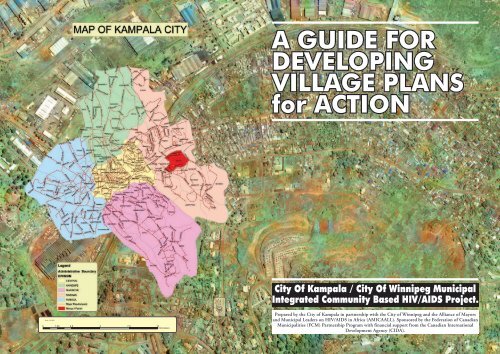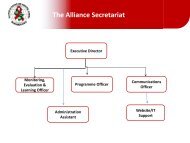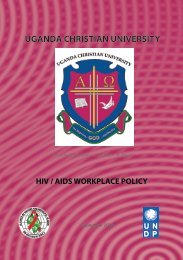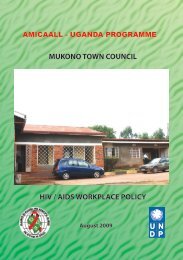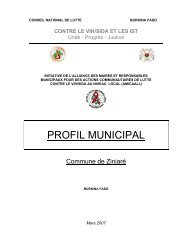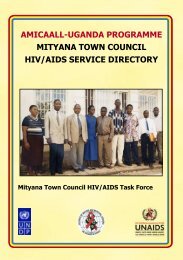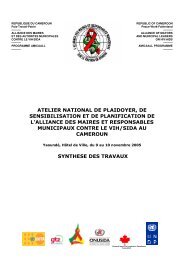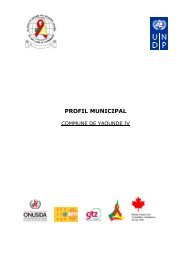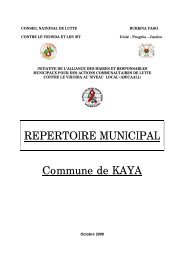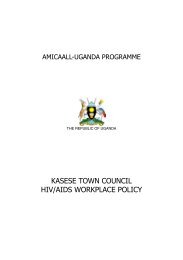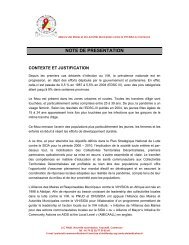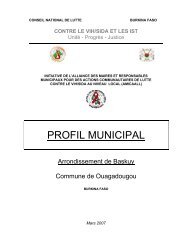A GUIDE FOR DEVELOPING VILLAGE PLANS for ACTION - amicaall
A GUIDE FOR DEVELOPING VILLAGE PLANS for ACTION - amicaall
A GUIDE FOR DEVELOPING VILLAGE PLANS for ACTION - amicaall
You also want an ePaper? Increase the reach of your titles
YUMPU automatically turns print PDFs into web optimized ePapers that Google loves.
A <strong>GUIDE</strong> <strong>FOR</strong><br />
<strong>DEVELOPING</strong><br />
<strong>VILLAGE</strong> <strong>PLANS</strong><br />
<strong>for</strong> <strong>ACTION</strong><br />
City Of Kampala / City Of Winnipeg Municipal<br />
Integrated Community Based HIV/AIDS Project.<br />
Scale 1:35,000<br />
0 1.25 2.5 5 7.5 10 Kilometers<br />
Prepared by the City of Kampala in partnership with the City of Winnipeg and the Alliance of Mayors<br />
and Municipal Leaders on HIV/AIDS in Africa (AMICAALL). Sponsored by the Federation of Canadian<br />
Municipalities (FCM) Partnership Program with financial support from the Canadian International<br />
Development Agency (CIDA).
TABLE OF CONTENTS<br />
INTRODUCTION......................................................................5<br />
PART ONE –A <strong>GUIDE</strong> <strong>FOR</strong> <strong>DEVELOPING</strong> <strong>VILLAGE</strong> <strong>PLANS</strong> <strong>FOR</strong> <strong>ACTION</strong><br />
1.1 What Is A Village Plan......................................................6<br />
1.2 Who Do You Involve..........................................................6<br />
1.3 Who Benefits From A Village Plan.....................................7<br />
PART TWO - GETTING STARTED......................................................10<br />
2.1 Checking Your Community Interest....................................10<br />
2.2 Understanding The Village.................................................10<br />
2.3 Establishing A Village Planning Team.................................11<br />
2.4 Community Dialogue.........................................................12<br />
2.5 Organizing The Planning Team For Action..........................13<br />
PART THREE - <strong>DEVELOPING</strong> THE <strong>VILLAGE</strong> VISION.........................15<br />
3.1 Gathering In<strong>for</strong>mation About The Village.............................15<br />
3.2 Assessing The Village’s Strengths,<br />
Weaknesses, Opportunities And Threats...........................17<br />
3.3 Drafting A Vision Statement...............................................18<br />
3.4 Getting Endorsement........................................................19<br />
PART FOUR - <strong>DEVELOPING</strong> AN <strong>ACTION</strong> PLAN...................................20<br />
4.1 Setting Goals And Objectives.............................................20<br />
4.2 Action Plans......................................................................21<br />
PART FIVE - HOW CAN WE MEASURE OUR PROGRESS.................22<br />
5.1 Progress Indicators...........................................................22<br />
5.2 Measurement...............................................................22<br />
PART SIX - <strong>VILLAGE</strong> PLAN APPROVAL...........................................23<br />
6.1 Communication And Consensus........................................23<br />
PART SEVEN - FROM PLANNING TO <strong>ACTION</strong> – IMPLEMENTING THE PLAN<br />
7.1 Preparing A Budget............................................................24<br />
7.2 Implementing The Village Plan............................................24<br />
7.3 Evaluation – How Well Did We Do....................................25<br />
7.4 Next Steps.........................................................................26<br />
APPENDIX I.......................................................................................27<br />
APPENDIX II......................................................................................28<br />
1
LIST OF ACRONYMS.<br />
CIDA Canadian International Development<br />
Agency<br />
FCM Federation of Canadian Municipalities<br />
AMICAALL Alliance of Mayors and Municipal Leaders<br />
on HIV/AIDS in Africa<br />
ULGA Uganda Local Government Associations<br />
DHAC District HIV/AIDS Committee<br />
KCC Kampala City Council<br />
UAAU Urban Authorities Association of Uganda<br />
UNDP United Nations Development Program<br />
FGDs Focus Group Discussions<br />
OVC Orphans and Vulnerable Children.<br />
UBOS Uganda Bureau of Standards<br />
UAC Uganda Aids Commission.<br />
LC Local Council.<br />
IGAs Income Generating Activities.<br />
2
ACKNOWLEDGEMENTS<br />
The City of Kampala/City of Winnipeg FCM Partnership<br />
Program would like to thank all the many organizations,<br />
groups and individuals in Kampala that made the creation<br />
and publication of this Guide possible. We acknowledge<br />
the leadership, guidance and support of the Alliance of<br />
Mayors and Municipal Leaders on HIV/AIDS in Africa<br />
(AMICAALL). We further acknowledge the significant<br />
contribution and active participation of the DHAC<br />
(District HIV/AIDS Committee) and LC1, LC3 and LC5<br />
representatives in developing the Guide.<br />
The “Guide <strong>for</strong> Developing Village Plans <strong>for</strong> Action” is part<br />
of the broader Municipal Integrated Community Based<br />
HIV/AIDS Project between the City of Kampala and the<br />
City of Winnipeg. We would like to express gratitude to<br />
the Kampala City Council (KCC) and the Winnipeg City<br />
Council <strong>for</strong> supporting the project and <strong>for</strong> endorsing the<br />
partnership in respective Council resolutions. A special<br />
thank you is given to the many Ugandan Government<br />
Ministries and organizations including the Uganda AIDS<br />
Commission, Ministry of Local Government, Ministry<br />
of Health-AIDS Control Programme, the Uganda Local<br />
Government Associations (ULGA), Urban Authorities<br />
Association of Uganda (UAAU) and UNDP-Uganda. We<br />
benefited greatly from your policy explanations, insights<br />
and advice about HIV/AIDS in Uganda.<br />
We would also like to acknowledge the on-going support<br />
and financial contributions of the Federation of Canadian<br />
Municipalities (FCM) and the Canadian International<br />
Development Agency (CIDA) without whom this municipal<br />
partnership would not have been possible.<br />
3
We hope that the “Guide <strong>for</strong> Developing Village Plans <strong>for</strong><br />
Action” will be a useful document <strong>for</strong> encouraging an<br />
inclusive process <strong>for</strong> broad community participation and<br />
dialogue in preparing a village plan that will contribute to<br />
the larger parish planning process.<br />
4
PART ONE – INTRODUCTION<br />
A new kind of partnership is developing between<br />
communities and government, built on co-operation<br />
and recognition of the creative ideas and skills that<br />
villages themselves have to offer. This guide is meant<br />
to help villages assess their strengths, identify their<br />
vision of a vibrant place to live, and come up with an<br />
action plan to achieve their local goals.<br />
Kampala City Council is encouraging villages to develop<br />
local plans <strong>for</strong> improvements through a participatory<br />
process. This is in line with the government decentralization<br />
process<br />
• The City of Kampala Policy requires that targeted<br />
villages develop local plans <strong>for</strong> integration into parish<br />
plans.<br />
• Kampala City Council encourages the development of<br />
an integrated plan that includes physical, economic<br />
and social goals to improve health and work against<br />
HIV/AIDS.<br />
This guide has been developed to assist villages and<br />
parishes to identify their priorities, organize, plan<br />
effectively and get some of the resources they may need<br />
to improve their villages in a sustainable manner.<br />
There is no “right” way to develop a village plan. Each<br />
village will need to adopt its own planning process to suit<br />
its unique situation.<br />
Every good planning process has certain “basics” in<br />
common.<br />
These include:<br />
• Representation and participation of all village<br />
stakeholders<br />
• Consensus Building towards decision making<br />
5
• Open Communication with people<br />
• Capturing all the gender issues.<br />
This guide includes suggestions on how to get started<br />
with your plan, steps to consider as you proceed, and<br />
where to find additional locally available resources. The<br />
appendix has a bibliography of resources grouped under<br />
topics you may wish to explore. This guide provides some<br />
examples and ideas that may help you. However, other<br />
projects and the Internet can also be great sources of<br />
reference material.<br />
1.1 WHAT IS A <strong>VILLAGE</strong> PLAN <strong>FOR</strong> <strong>ACTION</strong><br />
A village plan is a written document. It identifies issues of<br />
concern to that village. Opportunities, strengths, threats<br />
and weaknesses of a village are defined. It also provides<br />
practical actions that will result in an improved village. It<br />
provides opportunities <strong>for</strong> resource mobilization.<br />
A village plan does three essential things. It provides a<br />
VISION of what you would like your village to look like,<br />
sets out clear GOALS to achieve that vision, and gives you<br />
an <strong>ACTION</strong> PLAN to reach those goals.<br />
1.2 WHO DO YOU INVOLVE<br />
Developing a village plan helps concerned residents,<br />
local leaders, interest groups, civil society organizations;<br />
business communities, property owners and community<br />
organizations work together to identify important short and<br />
long-term goals. Everybody in that village is a stakeholder<br />
who could be involved.<br />
Representation from a broad range of local stakeholders<br />
will help strengthen your base of village support and make<br />
implementation of your action plan easier.<br />
6
1.3 WHO BENEFITS FROM A <strong>VILLAGE</strong> PLAN<br />
• Everyone who lives works, and plays in the village<br />
benefits from a village plan.<br />
• Well-developed village plans influence the development<br />
of the community and the city at large.<br />
• A plan will help Government departments; Local<br />
Governments, universities, other institutions and<br />
organizations better understand the priorities of your<br />
village so that they can work with you better.<br />
• Village plans benefit the parish.<br />
What are the benefits of a village planning process<br />
• It brings residents, business communities, and civil<br />
society organizations together to share ideas and work<br />
together on issues that are important to everyone.<br />
• It improves in<strong>for</strong>mation collection, sharing,<br />
communication, focuses ideas and builds consensus.<br />
• It helps a village identify its strengths and evaluate its<br />
own resources;<br />
• It increases the level of concern in the community about<br />
the problems that affect them.<br />
• It helps to translate community concerns into action.<br />
• It encourages creativity and builds partnerships both<br />
within and outside the village.<br />
• It enables others to become more in<strong>for</strong>med and<br />
responsive about what needs to be accomplished.<br />
• It can influence the policy and financial decisions of<br />
central, local government, development partners and<br />
the business community.<br />
• It helps the communities to build their capacities in<br />
implementation, monitoring of their activities in a<br />
sustainable manner.<br />
• It helps communities in identifying and mobilizing local<br />
and external resources.<br />
• It creates a sense of commitment, ownership and<br />
belonging in the community.<br />
7
1.4 STEPS IN THE <strong>VILLAGE</strong> PLANNING <strong>FOR</strong> <strong>ACTION</strong>.<br />
These are the typical steps that a village could follow in<br />
developing a village plan. Once a village planning team<br />
is established, it takes stock of what is in the community<br />
and the strengths and weaknesses of the area. Through<br />
open communication with local residents and business<br />
owners, the team develops an idea (or vision) of what the<br />
community would like the village to be within a given<br />
time frame (perhaps two or five years). To achieve that<br />
vision, the plan will include actions to reach those goals<br />
and objectives. To monitor progress, these actions and<br />
accomplishments need to be reviewed from time to time<br />
(e.g. every year), to measure and celebrate the successes<br />
of the plan. If necessary, changes can be made to better<br />
suit the current situation.<br />
THE STEPS IN THE <strong>VILLAGE</strong> PLANNING <strong>FOR</strong><br />
<strong>ACTION</strong>.<br />
1. Establishing a village planning team<br />
2. Creating a vision.<br />
3. Confirming the vision with the community<br />
4. Developing an action plan<br />
5. Getting community approval<br />
6. Implementing the village plan.<br />
7. Monitoring and evaluation.<br />
Establish a Village Planning Team of residents, leaders,<br />
business owners, village organizations, local agencies and<br />
other village stakeholders<br />
Develop your village Vision by – gathering in<strong>for</strong>mation<br />
about the area (i.e. the village profile)<br />
• Describe the village’s strengths and weaknesses<br />
• Describe its opportunities and resources<br />
Based on your assessment and your community<br />
consultation, draft a Vision Statement<br />
8
Confirm the vision with your community<br />
Develop the Action Plan<br />
• Goals<br />
• Objectives<br />
• Action Statements<br />
• Measurable indicators<br />
• Project descriptions budgets<br />
Distribute the plan and seek community approval<br />
through community gatherings, focus group discussions,<br />
workshops, meetings, questionnaires, etc. – <strong>for</strong>mal plan<br />
approval by Parish Development Committee, then Division<br />
Council and District Council<br />
Pre Implementation Capacity Development<br />
• Training<br />
• Skills Development<br />
Implement the plan<br />
• Develop projects<br />
• Develop budgets<br />
• Solicit funding<br />
• Oversee implementation<br />
• Asses the progress<br />
9
PART TWO - GETTING STARTED<br />
The first thing to remember is that a village plan must<br />
come from local people. It depends on local leadership<br />
and participation to be successful. To help you get<br />
started, here are some important first steps:<br />
1. Check <strong>for</strong> Community/village Interest<br />
2. Understanding your village<br />
3. Establish a Village Planning Team<br />
4. Communicate with your Village<br />
5. Organize <strong>for</strong> Action<br />
2.1 CHECKING <strong>FOR</strong> COMMUNITY/<strong>VILLAGE</strong><br />
INTEREST<br />
You will need to find a core group of opinion leaders, local<br />
leaders, and interest groups who are prepared to work<br />
with you to determine the level of community interest in<br />
the process of developing a village plan.<br />
• Develop a list of key people/groups who should be<br />
contacted, and reach out to as many people from the<br />
village as possible. If you don’t know where to start,<br />
talk to your local business owners, neighbours, people<br />
at the local church/mosques, cultural leaders etc.<br />
• Meet with these individuals and groups to determine<br />
their level of interest in taking part in the planning<br />
process.<br />
• Once you have met with these people, you will have a<br />
good idea of whether or not to proceed with developing<br />
a village plan.<br />
2.2 UNDERSTANDING YOUR <strong>VILLAGE</strong><br />
One of the first decisions to be made be<strong>for</strong>e starting to<br />
plan is how to define your village. A map of the area and<br />
discussion with your planning team is a good place to<br />
start. Ask yourselves the following questions:<br />
10
• What are the physical boundaries that describe the<br />
village<br />
• Is there a village register/book<br />
• Is there a social map<br />
• What social, economic and other characteristics best<br />
describe the make-up of the village<br />
2.3 ESTABLISHING A <strong>VILLAGE</strong> PLANNING TEAM<br />
The first important step is to establish a village planning<br />
team to develop a vision of the community. The more<br />
representative a village planning team is, the better the<br />
plan will be. Village planning team could include:<br />
• Local leaders (LCs).<br />
• Residents,<br />
• Business owners,<br />
• Landlords, and<br />
• Other key village representatives (i.e. schools, civil<br />
society organizations, religious and cultural groups,<br />
local agencies, etc.) A village planning team will<br />
be responsible <strong>for</strong> development of the plan and <strong>for</strong><br />
communicating with the village.<br />
Selecting members <strong>for</strong> the village planning team:<br />
How you establish your village planning team will influence<br />
both the quality of your plan and its reception in the<br />
community. Try to find those who are com<strong>for</strong>table working<br />
with people with diverse backgrounds and viewpoints.<br />
Every community has its leaders.<br />
• Consider the skills you want to bring to the planning<br />
team.<br />
• Invite people who are prepared to give their time and<br />
talent to participate in this process.<br />
• Membership should reflect the diversity of the<br />
village.<br />
11
Consider the size of the team.<br />
• Two of the members should be from the LCI executive<br />
(male and female).<br />
• It is important that the team is representative of the<br />
village.<br />
• Too large a group will not be effective.<br />
A selection process that is fair, open and inclusive will<br />
ensure community support. Some suggested approaches<br />
are:<br />
• Election by representation (i.e., decide the number<br />
of members from each sector of the community and<br />
establish a democratic process to elect members);<br />
• Election by geographic boundaries (i.e., if the village is<br />
large, you may want to break it down into manageable<br />
parts and host meetings to elect representatives from<br />
the smaller areas) and/or,<br />
• Interim appointments followed by a meeting to present<br />
planning team members and seek endorsement from<br />
the village <strong>for</strong> your team (this could be an election).<br />
This initial community selection process is timeconsuming<br />
but important <strong>for</strong> your success.<br />
2.4 COMMUNITY DIALOGUE<br />
“Getting the word” out to people in your village as you<br />
plan is important <strong>for</strong> a number of reasons:<br />
• It keeps everyone in<strong>for</strong>med as the process unfolds.<br />
• It invites members of the community to participate<br />
through meetings, focus groups, round table discussions<br />
and in<strong>for</strong>mation events.<br />
• It helps the planning team determine the village’s<br />
response to its ideas and proposals.<br />
There are several ways to get messages out to the village.<br />
Here are a few suggestions:<br />
• Talk about it –with villagers, business owners, school<br />
staff, etc.<br />
12
• Get sparking messages- to generate discussion with<br />
different members of the community.<br />
• Make posters – put them in places where lots of people<br />
will see them;<br />
• Do a mailbox drop – use the opportunity to talk to<br />
people who come to the door;<br />
• Initiate a telephone tree – get a group of people to call<br />
four or five people each. (This can be very effective in<br />
getting messages out to the community quickly).<br />
• Ask to post a notice on bulletin boards;<br />
• Set up an e-mail news group;<br />
• Contact radio and television stations to post a<br />
community service announcement;<br />
• Write an article <strong>for</strong> your local newspaper and/or<br />
• send SMS messages<br />
It is important to develop a communication strategy at<br />
the outset and stick with it. People are more likely to<br />
participate if they are kept in<strong>for</strong>med. Use whatever methods<br />
you think will work to capture the village’s interest and<br />
input. You are limited only by your own imagination and<br />
creativity!<br />
2.5 ORGANIZING YOUR PLANNING TEAM <strong>FOR</strong><br />
<strong>ACTION</strong><br />
Be<strong>for</strong>e you start developing your plan, here are some<br />
important things to think about:<br />
• Where and how often to hold regular meetings;<br />
• Selecting a chairperson – to keep order, call meetings<br />
or assign work;<br />
• Having someone volunteer to record minutes, so that<br />
everyone is clear about what you have decided;<br />
• Developing a rough schedule of what you think you will<br />
have to do to develop the village plan. Some things to<br />
think about include:<br />
13
• What might be involved at each stage<br />
• How much time should be allotted to accomplish<br />
each stage<br />
• Are there resources (people, materials) you will<br />
need to help accomplish your tasks<br />
Building an effective planning team:<br />
Part of getting organized is developing a sense of team<br />
spirit. You may want to consider bringing in a facilitator<br />
<strong>for</strong> a couple of sessions to help you:<br />
• Define the role of the planning team;<br />
• Deal with:<br />
- Basic group dynamics<br />
- Effective meetings<br />
- Leadership skills;<br />
- Focus the planning process – making plans that<br />
work;<br />
- Understand how to develop the village vision;<br />
and/or,<br />
- Develop the action plan.<br />
14
PART THREE - <strong>DEVELOPING</strong> YOUR <strong>VILLAGE</strong> VISION<br />
Your village VISION will define what you want to<br />
achieve <strong>for</strong> the village today and in the future. It<br />
should be realistic, clear and inclusive.<br />
To determine your vision, the team should ask the<br />
following questions:<br />
• What was the village like be<strong>for</strong>e<br />
• Where is the village like now<br />
• Where do we want the village to be in the next three to<br />
five years<br />
To answer these questions:<br />
1. Gather in<strong>for</strong>mation about the village (i.e., the<br />
Community Profile);<br />
2. Assess the village’s strengths and weaknesses;<br />
3. Draft a vision statement; and<br />
4. Get village endorsement.<br />
The following explains how to do this:<br />
3.1 GATHERING IN<strong>FOR</strong>MATION ABOUT THE<br />
<strong>VILLAGE</strong><br />
You may want a clear picture of the village’s key<br />
characteristics, past and present. This is called a<br />
community profile.<br />
Elements of a Community Profile:<br />
• Land Use Mapping – defines location and types of<br />
residential, commercial, institutional uses, etc.;<br />
• Demographic Data – statistics about the people who<br />
live in the village;<br />
• Community Assets and Resources – an inventory<br />
of village services and facilities and local agencies,<br />
organizations and groups; and,<br />
• Community Perceptions – what people are saying<br />
about their village.<br />
• Other in<strong>for</strong>mation, such as how the village is<br />
15
currently zoned, its physical assets (e.g. landmark<br />
buildings, parks, community centres, etc.) and the<br />
types of services in the area, (e.g. stores, health<br />
services, childcare, etc.) provide a snapshot of your<br />
village. Contact the City Council of Kampala <strong>for</strong><br />
some assistance with this.)<br />
Statistical data on the village, including population,<br />
household size, family composition, incomes, length of<br />
residency, etc., provides a profile of the people who make<br />
up the village. This in<strong>for</strong>mation can be accessed by<br />
contacting relevant city departments and organizations.<br />
Organizing a walk through the village can help your<br />
planning team identify the village’s physical assets, and<br />
take note of their condition. Walk as a team or split into<br />
small groups and take on a section of the village to do<br />
this exercise. Bring along a map, some paper and pencils<br />
and jot down your observations to share later with the<br />
planning group. A camera can serve as an excellent tool<br />
to develop the village inventory.<br />
Researching village organizations, community<br />
associations, cultural, religious, social and other<br />
community groups (with roots in the village) will provide<br />
insight into the level of resident involvement in the village.<br />
Meeting with key agencies, businesses, institutions, civil<br />
society organizations and local residents will provide<br />
insights into the opportunities and issues facing the<br />
village.<br />
Taking a survey, hosting focused discussions or holding<br />
small round table discussions are just a few of the methods<br />
you can use to gather insights about your community<br />
from the local people.<br />
16
3.2 ASSESSING <strong>VILLAGE</strong>’S STRENGTHS AND<br />
WEAKNESSES<br />
There are a number of planning tools that can assist you<br />
in assessing the village and developing the village vision<br />
statement. Appendix I gives you a guide to some of the<br />
questions you could answer about various characteristics<br />
of your village. A S.W.O.T. exercise (Strengths,<br />
Weaknesses, Opportunities and Threats), S.M.A.R.T.<br />
(Simple, Measurable, Achievable, Realistic, Time-frame),<br />
a P.A.T.H. process (Planning Alternatives Tomorrow with<br />
Hope) and a Future Scenario exercise can also help to<br />
focus your assessments and build consensus around<br />
what you want to achieve.<br />
Some questions common to any process you choose will<br />
be:<br />
• What are our strengths as a village – what do we do<br />
well<br />
• What opportunities exist in the village<br />
• What resources (people, places, programs and<br />
services) do we have<br />
• What are the barriers/threats (physical, financial,<br />
institutional, educational and environmental) that<br />
are preventing change<br />
• What in the village can we improve or change<br />
• What do we need to make our village a better place<br />
to live<br />
To help focus your discussion, consider asking the<br />
following questions: How can our village:<br />
• Attract and retain people<br />
• Improve access to HIV/AIDS programs and<br />
services<br />
• Attract and retain businesses<br />
• Develop recreation opportunities <strong>for</strong> children and<br />
families<br />
17
• Develop opportunities <strong>for</strong> employment, education,<br />
health services and training <strong>for</strong> local people<br />
• Create safe and attractive residential streets<br />
• Improve communication with each other about our<br />
village issues<br />
• Encourage/improve and sustain income generating<br />
activities<br />
3.3 DRAFTING A VISION STATEMENT<br />
A vision statement describes where you want your<br />
village to be in the next 3 to 5 years. It is based on the<br />
in<strong>for</strong>mation you obtain from the village assessments and<br />
the community consultations.<br />
The village planning team may choose to draft a series of<br />
statements to describe a probable future <strong>for</strong> the village,<br />
or a single statement to describe what you would like<br />
the village to become. There is no single right way to do<br />
this. Whatever process is followed in preparing the vision<br />
statement, be sure to:<br />
• Encourage full participation in discussion by all<br />
planning team members;<br />
• Focus on a realistic and achievable future based upon<br />
the village assessment;<br />
• Be conscious of the village’s people and their values;<br />
and,<br />
• Be conscious of the need <strong>for</strong> sustainable development<br />
that respects the environment (physical assets) as well<br />
as strengthening the economy (e.g. training, employment<br />
and business development).<br />
Some of the topics you may want to cover in preparing<br />
your vision statement might be:<br />
• The desired physical condition of the village;<br />
• The nature and quality of future services (e.g. health<br />
services, parks, etc.) and/or,<br />
18
• The desired social and economic outlook <strong>for</strong> the<br />
village.<br />
You may wish to use the S.M.A.R.T. approach to help<br />
develop the vision:<br />
• Simple<br />
• Measurable<br />
• Achievable<br />
• Realistic<br />
• Time-frame<br />
Here is an example of a vision statement:<br />
“In our vision of the future, the village, as the heart and<br />
pride of the city, encompasses all that is good about<br />
Kampala. It is a welcoming and caring place <strong>for</strong> all<br />
people. It provides jobs and services. It is a safe place<br />
that welcomes everyone. Furthermore, the village clearly<br />
understands and acts upon shared responsibilities”<br />
3.4 GETTING <strong>VILLAGE</strong> ENDORSEMENT<br />
Village endorsement of the vision statement(s) is essential<br />
to the success of your plan. There are many effective ways<br />
to seek village input and endorsement. For example,<br />
• Make copies available <strong>for</strong> public distribution and ask<br />
<strong>for</strong> comments.<br />
• Meet with community groups.<br />
• Organize in<strong>for</strong>mal discussion groups.<br />
• Hold public meetings<br />
• Publish in<strong>for</strong>mation in the local newspaper and provide<br />
a contact person to receive the feedback.<br />
• Take a survey.<br />
Input from consultations like these will help to clarify the<br />
vision statement(s) and build support in the village so<br />
that you can move <strong>for</strong>ward to action planning.<br />
19
PART FOUR - <strong>DEVELOPING</strong> AN <strong>ACTION</strong> PLAN<br />
A village plan sets out goals and objectives, and<br />
identifies actions to achieve them.<br />
A GOAL describes something you want to achieve to help<br />
realize your vision. You may have a long list of goals you<br />
want to accomplish. Grouping the village goals by themes<br />
or categories may help to focus your discussion. Here are<br />
some questions that may help you to set priorities:<br />
• What goals are most important to the village<br />
• What goals are the most practical and achievable<br />
An OBJECTIVE is something that must be done to achieve<br />
one of the village goals. Objectives should be specific and<br />
have a measurable outcome in a given time frame.<br />
An <strong>ACTION</strong> PLAN describes what you will do, when you<br />
want to do it, where you will get help, and what the costs<br />
will be. You may want to start with actions that can<br />
be accomplished in a short time frame. The success of<br />
these initial ef<strong>for</strong>ts will demonstrate to the villagers that<br />
changes are happening, and will help sustain interest and<br />
involvement as you progress through your plan. Try to be<br />
as specific as possible.<br />
The following example illustrates the above:<br />
Goal:<br />
To reduce the rate of HIV/AIDS in the<br />
community.<br />
Objectives: 1. To prevent transmission of HIV/AIDS.<br />
2. To provide care and support <strong>for</strong><br />
HIV/AIDS affected individuals and their<br />
families.<br />
3. To build community capacity to deal with<br />
HIV/AIDS.<br />
20
Action Plan:<br />
Objective 1<br />
To prevent the transmission of HIV/AIDS.<br />
Step 1: Meet with health staff, youth and others<br />
immediately to discuss issues and develop strategies<br />
to discuss post-test clubs, youth groups, schools, and<br />
churches. Resources required: Local HIV/AIDS Steering<br />
Committee, local health staff, village maps. Estimated<br />
cost: none.<br />
Step 2: Within three months, one post-test club or<br />
community initiative is established. Resources required:<br />
Local HIV/AIDS committee, local health staff meeting<br />
place. Estimated cost: 10,000 Ugx.<br />
Step 3: Within four months, a CHAI project will be in<br />
place. Resources required: Local HIV/AIDS committee.<br />
Estimated cost: 500,000 Ugx.<br />
Step 4: Within one year, anti retroviral treatment is<br />
available. Resources required: unknown.<br />
Objective 2<br />
To increase income among community members and those<br />
affected by/infected with HIV/AIDS through IGAs.<br />
Step 1: Make small loans available. Estimated cost:<br />
unknown.<br />
Step 2: Within one year, 60 beneficiaries have accessed<br />
loans and started income generating projects. Resources<br />
required: financial credit co-funding. Estimated Cost:<br />
30,000,000 Ugx.<br />
Step 3: Within five years, poverty levels have gone down,<br />
increased responses to HIV/AIDS is realized and provision<br />
of loans continues.<br />
21
PART FIVE - HOW CAN WE MEASURE OUR<br />
PROGRESS<br />
Developing Village Indicators<br />
Measuring progress will help you to build on your<br />
success and make adjustments to the village plan, based<br />
upon what you have learned. Such measurements are<br />
called indicators. Once you have decided what you will<br />
be measuring and how, you can monitor your progress,<br />
stimulate discussion and feedback from the village and<br />
adjust your action plan to reflect what you have learned.<br />
To illustrate this, consider the following example:<br />
Goal:<br />
To provide effective interventions that lead to improvement<br />
of the quality of life of orphans and other vulnerable<br />
children (OVC) living in Nakawa division.<br />
Objectives:<br />
1. To provide psychosocial support services that integrate<br />
HIV/AIDS prevention at a designated one stop centre in<br />
Nakawa division.<br />
Actions:<br />
Step 1: Rehabilitate and equip a building provided<br />
by Kampala city council to act as an OVC one-stop<br />
centre. Resources required: Unknown. Estimated cost:<br />
unknown.<br />
Step 2: Provide recreational services including games,<br />
sports, and HIV/AIDS related drama at the stop centre.<br />
Indicators of Success:<br />
• A rehabilitated and equipped building providing<br />
psychosocial support service.<br />
• 500 OVC accessing recreational services at the<br />
centre.<br />
Measurement Tools<br />
• Increasing number of OVC in the local communities<br />
requiring program intervention.<br />
• Lack of social services to respond to the needs of<br />
OVC.<br />
22
PART SIX - <strong>VILLAGE</strong> PLAN APPROVAL<br />
Communication is crucial to make sure the vision,<br />
goals, and proposed actions are widely known and<br />
generally agreed upon by the village. The more the<br />
village’s organizations and individuals are in<strong>for</strong>med<br />
about the proposed plan, the greater the acceptance<br />
of the plan is likely to be. Some methods of getting<br />
the plan out to the village include:<br />
• A series of “meetings at homes” at different times and<br />
at accessible location to encourage all members of the<br />
community to attend;<br />
• Parish Hall meetings to engage debate and discussion<br />
on the plan;<br />
• Distribution of the plan with an accompanying response<br />
questionnaire:<br />
• Media Events, such as interviews, articles, radio, etc.<br />
and/or,<br />
• Focus Group Discussions (FGDs).<br />
Whatever method you choose, keep your communication<br />
open and be prepared to modify the village plan in response<br />
to concerns raised by the community.<br />
23
PART SEVEN- FROM PLANNING TO <strong>ACTION</strong><br />
– IMPLEMENTING THE PLAN<br />
Once you have achieved community consensus on the<br />
village plan, you are ready to develop your projects<br />
and prepare budgets to carry them out.<br />
7.1 PREPARING A BUDGET<br />
Some projects will require little or no funding, but will<br />
rely on community volunteers. Others may carry a big<br />
price tag. You may want to consider asking <strong>for</strong> input<br />
to work out the details of your project and put together<br />
a realistic budget. Demonstrated community support,<br />
complementary funding and volunteer commitment all<br />
help to strengthen your funding proposals.<br />
Most funders require you to enter into an agreement<br />
or contract in order to proceed with your project. The<br />
planning team must have a method to be accountable <strong>for</strong><br />
the monies it receives.<br />
7.2 IMPLIMENTING THE <strong>VILLAGE</strong> PLAN<br />
Now that the community plan has been developed it can<br />
be put into action. But it’s not over yet! Now comes the<br />
exciting part – overseeing actual implementation of the<br />
projects. To carry out the plan and its many projects<br />
will require a number of people and a variety of skills.<br />
The more involved the village becomes, the more exciting<br />
the project will be. Delegating of responsibility to people<br />
outside the planning team and coordinating ef<strong>for</strong>ts with<br />
other groups may be required. The budget might enable<br />
you to hire someone with special skills to help the village<br />
with implementation.<br />
• In the village plan, there can be objectives/actions<br />
the village can implement on their own, while others<br />
may require approval from local governments (LC3<br />
or LC5).<br />
24
• A village plan can be a very useful document to the<br />
parish planning process. There<strong>for</strong>e, villages can tap<br />
on resources beyond their locality to implement the<br />
plans.<br />
AND REMEMBER TO TAKE TIME OUT TO CELEBRATE<br />
ACHIEVEMENTS WITH MEMBERS OF THE<br />
COMMUNITY!<br />
Volunteers and the community need to feel that they are<br />
valued <strong>for</strong> their contributions. A function to celebrate<br />
successes will go a long way in helping the community<br />
members see that their ef<strong>for</strong>ts are needed and that there<br />
are visible results of their work in their community.<br />
7.3 MONITORING AND EVALUATION – HOW WELL<br />
DID WE DO<br />
Monitoring is a continuous assessment of the activities<br />
while evaluation is seeing the outcome of the projects that<br />
will help determine how well the planning has worked,<br />
and how you want to continue. Village stakeholders,<br />
government, donors and other communities can all benefit<br />
from the in<strong>for</strong>mation you obtain.<br />
To undertake an evaluation:<br />
• Decide on the methods <strong>for</strong> gathering feedback/<br />
results (i.e., interviews, surveys, photographs, etc.).<br />
• Ask yourselves<br />
• Did we achieve what we wanted<br />
• What lessons did we learn from this experience<br />
that we could apply in future<br />
• Did the community appreciate the process<br />
• Would you recommend the process to another<br />
village<br />
• Communicate the progress to all of the village<br />
stakeholders – the councils, the community at<br />
large, the funding partners and any other interested<br />
parties.<br />
25
7.4 NEXT STEPS<br />
The village planning team may want to review the plan<br />
on a regular basis to set new goals. This may be based<br />
upon lessons learned from the monitoring and evaluation<br />
process or those that respond to changes that are occurring<br />
naturally in the village. Some questions you may wish to<br />
explore are:<br />
• Do some projects need more attention than others<br />
• What new issues have arisen<br />
• What new opportunities do we have<br />
• What new resources have we created or found<br />
• What new goals can we decide upon<br />
• What new strategies could be employed<br />
A final, but important question <strong>for</strong> the group to consider<br />
is:<br />
• Should the village planning team continue<br />
This group has played a valuable role in guiding and<br />
assisting local initiatives, and could continue to do so in<br />
the future. Keep together and keep the momentum going.<br />
You have worked long and hard to get to this point. It is<br />
important to stay involved in future action plans that may<br />
need pursuing in your quest to meet the village’s goals.<br />
26
Appendix I: PRA Tool; SWOT Analysis<br />
Understanding Strengths,Weaknesses, Opportunities<br />
and Threats<br />
Why use the tool<br />
SWOT Analysis is an effective way of identifying your Strengths<br />
and Weaknesses, and of examining the Opportunities and<br />
Threats you face.<br />
How to use the tool:<br />
To carry out a SWOT Analysis one writes down the answers<br />
to the following questions. Where appropriate, use similar<br />
questions:<br />
Strengths:<br />
• What advantages do you have<br />
• What do you do well<br />
What relevant resources do you have access to<br />
What do other people see as your strengths<br />
Weaknesses:<br />
• What could you improve<br />
• What do you do badly<br />
• What should you avoid<br />
Opportunities:<br />
• Where are the good opportunities facing you<br />
• What are the interesting trends you are aware of<br />
• Changes in technology and markets on both a broad and<br />
narrow scale<br />
• Changes in government policy related to your field<br />
• Changes in social patterns, population profiles, lifestyle<br />
changes, etc.<br />
• Local Events<br />
Threats:<br />
• What obstacles do you face<br />
• What is your competition doing<br />
• Are the required specifications <strong>for</strong> your job, products or<br />
services changing<br />
• Is changing technology threatening your position<br />
• Do you have bad debt or cash-flow problems<br />
• Could any of your weaknesses seriously threaten your<br />
business<br />
27
Appendix II: List of Members Who Attended the Review<br />
Meetings<br />
NAME<br />
ORGANISATION<br />
1. Dr. Mugisa John AMICAALL<br />
2. Mr. Muganzi Naboth Council agent-Banda<br />
3. Ms Lubuuka Halima BCDP<br />
4. Ms Naikesa Robina Nakawa KCC<br />
5. Mr. Balyeidusa C. LCII Mbuya I<br />
6. Mr. Agaba Johnson KCC HIV/ AIDS<br />
7. Mr Nyamutale A.T.<br />
Placid<br />
Fisheries/DHC<br />
8. Mr. Gordon Stelman City of Winnipeg<br />
9. Mr. Kayoa Paul Mbuya barracks CHAI<br />
10. Mrs Ruth Muganzi KCC<br />
11. Mr. Gerald Sseguya AMICAAL<br />
12. Mr. Byenkya Charles AMICAALL<br />
13. Mr. Katungi B.N.R. Makerere University<br />
14. Mrs. Ursula Stelman K’la Winnipeg Partneship<br />
15. Mrs. Baryayebwa Diana KCC<br />
16. Mr. Jeremy A. Magimbi Educ Dept-KCC<br />
17. Ms Nandago Catherine AMICAALL<br />
18. Ms Halima Yunus CSO Nakawa<br />
19. Mr. Tabuzibwa Michael DHE<br />
20. Mr. Nsereko L. DEO Nakawa<br />
21. Mr. Nsimbi Livingstone B. KCC HIV/AIDS<br />
22. Ms Kagezi Brenda KCC HIV/AIDS<br />
23. Dr. Sendagire I. HIV/AIDS DFP<br />
24. Mr. Katabazi G.K. Division Planner<br />
25. Ms. Claire Akun N. AMICAALL<br />
28


